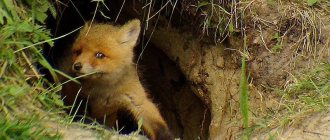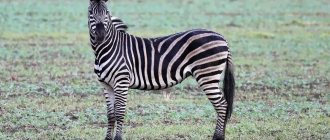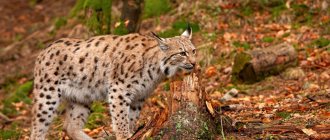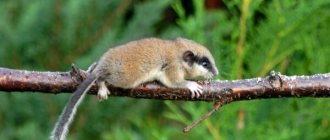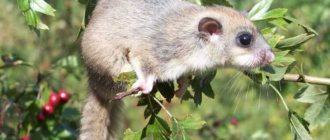External features of the animal lynx
The photo of the animal lynx shows an outwardly attractive, fluffy cat, the length of which varies from 80 to 130 centimeters. Height at withers 50-70 centimeters. Basically, the size of a lynx is similar to that of a large dog. An adult lynx weighs from 18 to 35 kilograms. The cat's ears end in long tufts and the tail is short. The lynx's large, high paws, which grow long hair in winter, help them move through the snow without any problems.
Depending on the territory where the lynx lives, its color varies, from red to smoky, with spots on the back, sides and paws. The predator has a unique silky coat. The claws of the lynx, like those of other feline predators, do not leave imprints on the snow.
Interesting Facts
- Since ancient times, the lynx was considered a sacred animal in Scandinavian mythology; it was depicted harnessed to the chariot of the goddess Freya.
- Maine Coon cats, which are essentially the largest cats in the world, according to some theories, trace their ancestry back to the lynx.
- The lynx also has its place in heraldry; the lynx depicted on various medieval coats of arms symbolizes visual acuity.
Sources
- https://wildfauna.ru/rys
- https://www.poznavayka.org/zoologiya/ryis-hishhnik-semeystva-koshachih/
- https://faunistics.com/rys/
- https://FB.ru/article/163012/chem-pitaetsya-ryis-v-lesu-chem-pitaetsya-ryis-v-tayge
[collapse]
Lynx habitat
The territory where the lynx lives is the north; sometimes it lives even beyond the Arctic Circle. The lynx's favorite habitats are dense forests, although it is found in a variety of places.
Previously, the predator was distributed throughout European territory, but in the 20th century it was exterminated in many countries. At the present time, successful attempts are being made to revive the lynx. In the Russian Federation its numbers are small.
Characteristics of the taiga
The taiga, or edge of the northern coniferous forests, is a wide strip of coniferous forests located between the tundra and a strip of temperate deciduous forests. These lands occupy about 20 million km2, accounting for 17% of the total land area of the planet.
The climate of the taiga is harsh, but at the same time it allows a fairly large part of the flora and fauna to live wonderfully in these latitudes. Summer here is short, not too hot, but not cold either. But the winter is long with heavy snow and frost.
The taiga is divided into two parts:
- Open taiga is an area of rich pastures with trees widely scattered across them;
- Dense forests - where the entire undergrowth is in the shade and serves as an excellent shelter and food source for the representatives of the animal world inhabiting it.
Lynx animal diet
The lynx is an excellent hunter, which is aided by its excellent ability to climb trees. Another factor that helps in hunting is good camouflage. Spots on the fur make the lynx invisible during the day, among the glare of the sun, and help to hide at dusk, which makes it easier to attack the prey.
If there is enough food, then the lynx lives in one place, but if not, then it moves. It can travel within thirty kilometers per day.
Basically, what the lynx feeds on are hares, grouse birds, small rodents and small ungulates, as well as sables and foxes. Rarely attacks domestic dogs.
The lynx's favorite time of day for hunting is twilight. She prefers to ambush her prey or sneak up on her at a close distance, which can be overcome in one jump. The cat's jump reaches four meters. He likes to hide behind large stones or fallen tree trunks.
Does not pursue prey for more than a hundred meters. The lynx digs its claws into large prey and strangles it. The predator does not eat much meat at a time, hides the leftovers, but does not do it carefully and often the prey is carried away by other predators. Depending on the size of the prey, it can store uneaten leftovers for up to one and a half weeks.
It happens that during a hunt, a lynx, a more skilled hunter, is pursued by a wolverine. After the cat has caught the prey, the wolverine drives it away and eats the meat of the killed animal. Lynxes, like wolves, are considered forest orderlies, since they kill mainly sick and weak animals.
Behavior and lifestyle
This is a predator that leads a solitary lifestyle after dark. During the period of feeding and raising offspring, the female lives with her cubs for several months.
Interesting to know! At dusk, lynxes go hunting. Thanks to the “tassels” on their ears, lynxes are perfectly oriented in space and sense their potential prey.
Lynxes hunt their prey in various ways: they can sneak up unnoticed or wait for animals next to their paths, being in ambush. They also visit places where ungulates quench their thirst.
All types of lynx
There are several subspecies of lynx:
- Ordinary. The most common subspecies of lynx.
- Canadian. Mainly distributed in Canada. The fur is grayish-brown. Half the size of the common lynx.
- Pyrenean. Habitat: southwest Spain. The rarest subspecies living in the wild. It is listed in the Red Book and is the rarest mammal on earth. The fur is light in color and has bright spots.
- Redhead. Habitat: United States of America. The fur is red with a gray tint, but there are individuals that are completely black - melanistic. It is seriously inferior in size to the common lynx and weighs only 6-11 kilograms.
Where do they live?
The lynx's habitat covers North America, northern and central Europe and Asia. A few local populations are found in Germany, Italy, Spain, and the countries of the Balkan Peninsula. The lynx is found in the Caucasus, Turkey, Pakistan, Iraq and Iran.
Where live
The most suitable habitat for lynxes is dense coniferous forests. The highest population density is observed in the taiga. In such natural zones as tundra, forest-tundra, forest-steppe, where open areas predominate, the animal is much less common.
Observation of predators living in the Stolby, Bashkiria nature reserves, and the Voronezh Natural Biosphere Reserve made it possible to establish that each adult occupies a forest area of up to 200 square meters. km. If there is enough prey, the plots may be smaller. The lynx leaves its habitat only in exceptional cases: in the absence of food or during a natural disaster.
Lynx breeding
At the beginning of spring, the lynx begins the mating season, during which, the rest of the time, the quiet cat makes piercing sounds: screams and meows. During this period, several males fighting among themselves follow the female.
The resulting couple sniffs each other and rubs their foreheads. When cats become attached, mutual licking of fur occurs. The rest of the time, with the exception of the breeding season, the cat prefers solitude.
The female bears it within seventy days, after which 1 to 5 deaf and blind lynx cubs are born. Kittens weigh about three hundred grams. The lynx chooses earthen caves, rock crevices or among windbreaks as a den for its offspring. Lynx cubs begin to see on the twelfth day, and at one month they can already eat solid food.
Both the male and the female are involved in raising the offspring. Growing kittens live and learn to hunt with their parents until the next mating season, and then leave and live separately. By the age of two, the female is capable of reproduction, while the males are only capable of reproduction by the age of three. Lynxes live for about 15-20 years.
Lifestyle
The lynx animal prefers to live in deep, dark forests. Also, forests located at higher elevations can become its place of residence. May wander into the forest-steppe or forest-tundra.
Our animal has several advantages that allow it to be at its best compared to other types of predatory animals. She climbs trees very well, runs fast, jumps far and swims well.
We previously wrote that it can live within the Arctic Circle and beyond it. In such places she feels great, the only thing that may not suit her is the lack of food in sufficient quantities.
The lynx leads a sedentary lifestyle only if there are plenty of small and large animals. Otherwise, it begins to migrate from one place to another in search of food.
Enemies of the lynx in the wild
Despite the small commercial value of the lynx, only fur is used; the main enemy of the predator is humans. In addition to humans, in nature, the enemies of the lynx are wolves, which are characterized by pack hunting and relatives who want to occupy the developed territory or kill kittens.
A single cat tries to avoid the territories where wolves live, since entering into battle with a pack means dooming oneself to death in advance.
Regarding its relatives, the lynx marks its boundaries, and if they are violated, it can scare away uninvited guests with a hiss or engage in a fight.
Hunting
The lynx goes hunting in the dark. This fact completely destroys the myth that it jumps from a tree onto its prey. Tries to get as close to prey as possible, often trying to hide near a fallen tree or in dense bushes.
Choosing the most appropriate moment, usually this is a distance of 10 - 15 meters and instantly attacks, making jumps from 3 to 5 meters. Once caught in the paws and teeth of a predator, the prey dies within a few seconds.
Razor-sharp teeth and claws tear arteries in the neck and flesh of the animal, leaving no chance of salvation. Having eaten enough, she hides the remaining food in the snow or under small tree branches. A less fortunate hunter likes to follow the lynx - the wolverine, who is not averse to feasting on the remains of the prey.
If larger prey is being hunted, a surprise may await the wild cat. When it attacks a sika deer, it is able to drag a lynx on itself for several meters; sometimes the victim manages to escape from the tenacious clutches of the predator. But if you trust the statistics, in most cases, the cat kills its victim after some time.
Lynx at home
The caracal is a domestic lynx, characterized by excessive energy and a pronounced hunting character. Initially, the predator was tamed for hunting game; the ownership of this animal began to be a sign of wealth.
The habitat of wild caracals is Africa and Asia. The caracal is smaller in size than the common lynx. The short coat is sandy in color with dark ears. The weight does not exceed 25 kilograms, and the height is 50 centimeters. The predator feeds on meat and eats up to one and a half kilograms per day.
Caracals are ready to breed when they reach one year of age. The mating season lasts from early autumn to early winter. This is mainly due to the animal having excess food at this time of year. Pregnancy lasts for 2-4 months. Usually 2 to 7 lynx cubs are born. By six months, kittens begin to live independently.
Caracals have strong natural immunity and rarely get sick. Such predatory cats live for about fifteen years.
Population and status
On the territory of the Balkan Peninsula there are no more than a few dozen individuals, and in Germany, Switzerland and France at one time lynxes were completely exterminated, which required their repopulation.
The largest numbers of this predator are observed in the Carpathians and Poland. No less numerous populations are also characteristic of Belarus, Scandinavia, Central Asia, Latvia and Estonia. This representative of the cat family is also found in Siberia.
The common lynx is not of particular importance for commercial production, although the fur of this animal is highly valued. This is due to the fact that the lynx has thick, silky and long (up to 7 cm) fur, with a rather thick and warm undercoat. It should be noted that lynxes play a very important role in maintaining the balance of nature.
It is believed that the taste characteristics of lynx meat are quite high, since its taste characteristics are similar to veal. Despite this, in most countries lynx meat is not eaten, although it is quite tasty and tender.
Interesting to know! In ancient times in Rus', rich nobles were treated to lynx meat, and dishes prepared from the meat of this animal were always present on the tables of boyars and princes as an expensive delicacy.
A characteristic feature of European territory is the fact that even in the last century the number of lynxes did not exceed several hundred individuals.
In the territory of European countries, even in the last century, the number of common lynx decreased significantly and amounted to only a few hundred individuals. This became possible due to the fact that forests began to be actively destroyed, poaching began to flourish, and against this background the food supply was reduced. Nowadays, a lot of measures are being taken that are aimed at preserving the populations of this unique animal, as well as, if possible, increasing its numbers.
Photos of all types of lynx
Description
Very similar to everyone’s favorite cat, but much larger. True, in its family, this representative is not huge in size. From 75 to 130 cm is the length of an adult male, and the female does not exceed 125 cm in length. The weight of a lynx is within 25, sometimes 30 kg.
The body of a forest cat is short, flat on the sides, and tightly knit. The paws are strong and thick. The round head has elongated ears, the ends of which are decorated with distinctive tassels. If you trim them, the lynx's hearing will be much reduced (and this is a fact).
Note!
- Removal and cremation of animals
- Cynologists - who are they?
- Car soundproofing. What is she like?
The body of the animal is covered with soft and very thick fur. The color depends on the species to which the lynx belongs. The tail is short, as if severed.
There is a myth about the goddess of agriculture, Demeter, who punished the Scythian king, who wanted to appropriate inventions for cultivating the land. She turned him into a lynx, and the royal dagger cut off the animal's tail.
How does this cat hunt?
The common lynx lies in wait for its prey, hiding near a tree or next to a well-trodden path. When the prey approaches the required distance, the hungry cat makes a lightning-fast jump onto its back, gnawing its prey. According to Professor Drozdov, in the north of America these creatures hunt almost everything that can move. However, even here, hares remain the favorite delicacy of these cats.
It is curious that in Scandinavia lynxes love to bully reindeer. In areas with a cold climate, the carcasses of animals killed by lynx (for example, deer) stiffen quite quickly, so the cat needs to feast on their meat as soon as possible. Otherwise, her muzzle will literally freeze to the prey! By the way, these cats are afraid of people and always try to avoid meeting them. But there is no need to abuse this, because driven and wounded lynxes become very dangerous and ferocious creatures!
View gallery


